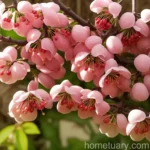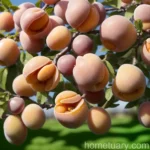Cherry Plum (Prunus cerasifera ‘Thundercloud’)
Cherry plum, scientifically known as Prunus cerasifera ‘Thundercloud’, is a stunning ornamental tree that is highly valued for its beautiful purple foliage and delicate pink blossoms. This cultivar is a favorite among many gardeners and landscapers for its aesthetic appeal and relatively low maintenance requirements. In this comprehensive guide, we will delve into the various aspects of cherry plum cultivation, including its cultural needs, uses, water and sunlight requirements, fertilizer needs, soil preferences, pruning techniques, propagation methods, container cultivation, common diseases, pest management, and interesting botanist’s tips.
What is Cherry Plum (Prunus cerasifera ‘Thundercloud’)?
Cherry plum, also known as Thundercloud cherry plum, is a small deciduous tree that belongs to the Rosaceae family. It is native to regions in Asia and Southeast Europe. The tree is known for its striking deep purple to almost black foliage, making it a popular choice for adding dramatic visual interest to landscapes. Additionally, the tree produces charming light pink flowers in the early spring, further enhancing its allure.
Key Takeaways
Before delving into the specifics of cherry plum cultivation, let’s take a brief look at the key takeaways associated with this fascinating plant:
- Scientific Name: Prunus cerasifera ‘Thundercloud’
- Common Names: Cherry plum, Thundercloud cherry plum, purple leaf plum
- Cultivar Type: Deciduous ornamental tree
- Foliage Color: Deep purple to almost black
- Flower Color: Light pink
- Cultural Uses: Ornamental, landscaping, small fruit bearing
- Preferred Growing Zones: Typically thrives in USDA zones 5-8
- Mature Height: 15-25 feet
- Growth Rate: Moderate
- Soil Preference: Well-draining, loamy soil
Now, let’s explore each aspect of cherry plum cultivation in more detail.
Culture
Culturally, cherry plum plants thrive in certain conditions and require specific care to reach their full potential. Understanding the cultural requirements of this plant can significantly influence its growth, appearance, and overall health.
Uses
The cherry plum tree serves various purposes, making it a versatile addition to gardens and landscapes. Common uses of cherry plum include:
- Ornamental Purposes: Its vibrant purple foliage and delicate pink blossoms make it a striking ornamental addition to any landscape.
- Landscaping: Cherry plum is often used in landscaping to add color contrast and interest to outdoor spaces.
- Fruit Bearing: Some cultivars of cherry plum produce small, edible fruits that can be used for culinary purposes, such as making jams and preserves.
Water
Proper watering is essential for the health and vitality of cherry plum trees. While these trees are relatively drought-tolerant once established, adequate moisture is crucial during the establishment phase and in times of prolonged drought. It is important to strike a balance and avoid waterlogging as it can lead to root rot and other issues.
Sunlight
Cherry plum trees thrive in full sun to partial shade conditions. They require at least 6-8 hours of direct sunlight daily to ensure optimum growth and stunning foliage coloration. Planting them in a location with ample sunlight exposure is crucial for their overall health and vigor.
Fertilizer
Appropriate fertilization can significantly impact the growth and development of cherry plum trees. A balanced, slow-release fertilizer formulated for fruit trees or ornamentals can be applied in early spring to provide the necessary nutrients for healthy growth and flowering.
Soil
Cherry plum trees prefer well-draining, loamy soil for optimal growth. The soil should be fertile and slightly acidic to neutral in pH. Additionally, ensuring good soil aeration and drainage is critical to prevent waterlogged conditions that can lead to root rot.
Pruning
Pruning is an essential aspect of cherry plum tree care, serving to maintain its shape, promote healthy growth, and encourage abundant flowering. Proper timing and technique are crucial for successful pruning.
Propagation
Cherry plum trees can be propagated through various methods such as seeds, cuttings, and grafting. Each propagation method has its own set of advantages and challenges, and the choice of method can depend on the specific goals and resources of the grower.
Container Cultivation
Cherry plum can also be grown in containers, making them suitable for smaller gardens, patios, and urban landscapes. Container cultivation requires special attention to watering, fertilization, and root space management.
Popularity
Cherry plum, particularly the ‘Thundercloud’ cultivar, has gained popularity among gardeners and landscapers for its stunning foliage color and ornamental value. Its adaptability and relatively low maintenance requirements make it an appealing choice for a wide range of planting schemes.
Common Diseases
Cherry plum trees are susceptible to certain diseases that can affect their overall health and vigor. Understanding these diseases and their symptoms is crucial for effective management and prevention.
Disease Diagnosis
Diagnosing diseases in cherry plum trees involves identifying common symptoms such as leaf spots, wilting, and unusual discoloration. Proper diagnosis is essential for implementing targeted treatment measures.
Common Pests
Cherry plum trees are prone to attacks by certain pests, including aphids, scale insects, and caterpillars. Monitoring for pest activity and implementing appropriate pest management strategies is important for maintaining tree health.
Botanist’s Tips
As a plant scientist, I have some valuable tips for cultivating and caring for cherry plum (Prunus cerasifera ‘Thundercloud’):
- Soil Preparation: Prior to planting, ensure the soil is well-draining and has been enriched with organic matter to provide the tree with a favorable growing medium.
- Mulching: Apply a layer of organic mulch around the base of the tree to conserve soil moisture, suppress weed growth, and protect the roots from temperature fluctuations.
- Pruning Practices: When pruning, focus on removing dead, damaged, or diseased branches to maintain the tree’s structure and promote strong, healthy growth.
Now that we’ve covered the various aspects of cherry plum cultivation, let’s explore some fun and interesting facts about this captivating tree.
Fun Facts
- The ‘Thundercloud’ cultivar of cherry plum is known for its exceptional foliage color, with leaves ranging from deep burgundy to almost black.
- Cherry plum trees are valued for their early spring bloom, producing an exquisite display of pale pink flowers.
- While some cherry plum cultivars produce edible fruits, their primary appeal lies in their ornamental characteristics.
Links to External Resources
To gain further insights into cherry plum (Prunus cerasifera ‘Thundercloud’) and its cultivation, you may find the following resources helpful:
- Royal Horticultural Society – Prunus cerasifera ‘Thundercloud’
- Missouri Botanical Garden – Prunus cerasifera ‘Thundercloud’
- University of Florida IFAS Extension – Cherry Plum Cultivars
In conclusion, cherry plum (Prunus cerasifera ‘Thundercloud’) is a mesmerizing ornamental tree with its captivating purple foliage and delicate pink blossoms. Understanding its cultural requirements, disease management, and propagation methods can help enthusiasts and horticulturists appreciate and cultivate this enchanting plant to its fullest potential.
Remember, while the information provided here serves as a comprehensive guide, the specific requirements for growing cherry plum may vary based on regional climates and soil conditions. It’s always beneficial to consult local horticultural experts or extension services for tailored recommendations when growing cherry plum in your area. Happy gardening!















